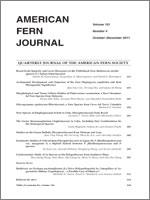Matteuccia struthiopteris (Onocleaceae) has a present-day distribution across much of the north-temperate and boreal regions of the world. Much of its current North American and European distribution was covered in ice or uninhabitable tundra during the Pleistocene. Here we use DNA sequences and AFLP data to investigate the genetic variation of the fiddlehead fern at two geographic scales to infer the historical biogeography of the species. Matteuccia struthiopteris segregates globally into minimally divergent (0.3%) Eurasian and American lineages. These two clades have little to no variation even at large geographic scales. Within hemisphere, patterned genetic variation was evident only in the AFLP data and only locally. Genetic variation within Vermont was greater within the westward-trending Winooski River watershed than in the Passumpsic River watershed, which drains east into the Connecticut River. We suggest that historical factors have created this pattern; a Mississippi Valley Pleistocene refugium for the American lineage of the species seems plausible.
How to translate text using browser tools
1 October 2011
Broad-Scale Integrity and Local Divergence in the Fiddlehead Fern Matteuccia struthiopteris (L.) Todaro (Onocleaceae)
Daniel M. Koenemann,
Jacqueline A. Maisonpierre,
David S. Barrington
ACCESS THE FULL ARTICLE

American Fern Journal
Vol. 101 • No. 4
October 2011
Vol. 101 • No. 4
October 2011
AFLP
biogeography
Matteuccia
Onocleaceae
pgiC
Pleistocene




